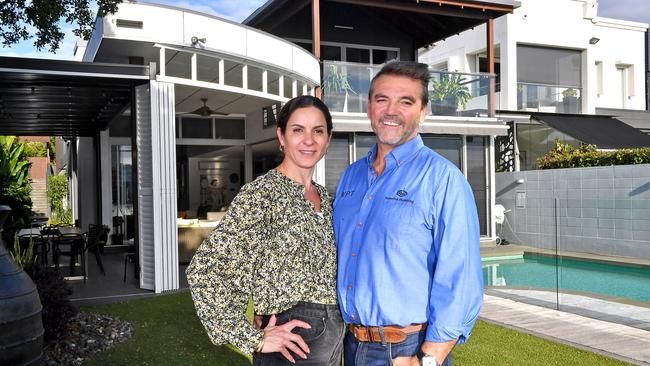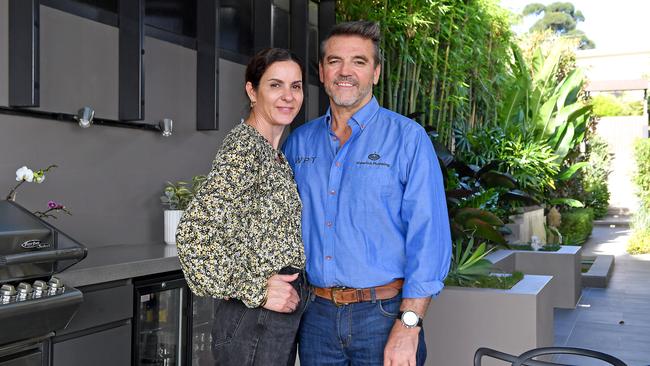Gloomy outlook for housing market despite RBA ‘reprieve’
The experts differ in their views about the property market’s response to the economic times. But all agree we are in for a bumpy ride.

The outlook for the nation’s residential market has been darkened by sharemarket volatility and interest rate rises.
While there was some relief this week as the Reserve Bank delivered something of a reprieve on the rates front, investment houses are sticking to their forecasts of a 20 per cent house price declines.
A peak to trough fall like this would drag the once rampant housing market back to earth at the rate at which the Global Financial Crisis flattened US housing.
Australians are not likely to walk away from their mortgages as Americans did in the great US downturn, but there is pain to come.
The market is deflating after very significant rises that kicked off when the cocktail of near zero rates and government stimulus prompted a surge in demand at the onset of the pandemic.
Market dynamics have now turned as the global stimulus tap is turned off and economies slow. Sales are slower in many markets than last year but agents say the spring selling season is off to a reasonable start and monthly house price data recorded a slowdown in the rate of declines through September.

The chief executive of national real estate firm The Agency, Geoff Lucas, expects the market to reach an “equilibrium” midway through next year as buyers’ and sellers’ expectations moderate after September sales volumes hit an eight-year low.
There were several factors at play, he said. While interest rates had been the primary activity driver, Mr Lucas said the bulk of borrowers on fixed rates had loans that were expected to expire between June and December 2023, meaning a significant portion of homeowners would see their monthly repayments jump from lows during the pandemic to potentially decade highs.
“The feeling is there is at least a three-month lag in between the increase and hitting the consumer pocket,” he said. “That puts pressure on their borrowing capacity and cash flow.”
PropTrack senior economist Eleanor Creagh said the combination of interest rates moving sharply higher, rising mortgage rates and expectations of continued price falls was weighing on buyer demand and contributing to slowing selling activity. Unlike the seasonal uptick in activity that September has brought over the past two years, at a national level preliminary sales volumes show that transactions fell during spring.
Nationally, preliminary monthly sales volumes fell 3 per cent month-on-month in September. But Canberra, Hobart, Sydney and Darwin have bucked the trend, recording the typical seasonal uptick.
Ms Creagh says the market could shift again.

“The spring selling season may have got off to a slow start with the public holidays weighing on activity, but now the expectation that interest rates might not climb so high and so fast could give some prospective buyers a confidence boost, leading to an uptick in activity through October,” she said.
While volumes are down, buyer interest has yet to wane, with many now using the slowdown in activity to take their time and negotiate, according to the executive chairman of Yellow Brick Road Home Loans, Mark Bouris. He said the language used by the Reserve Bank on Tuesday – acknowledging the “substantial” rate increases through 2022 and “uncertain” global economy – should be seen by buyers as a coded message.
“That suggested to me that, given the rhetoric … that they are going to slow down a bit,” Mr Bouris said.
“When the Reserve Bank says that … the buyers take that signal and say ‘hang on, I shouldn’t be hanging out to see how much hurt the Reserve Bank is going to continue to apply to homeowners’.”

Grant Scott and Luisa Nardi-Scott are selling their home on the edge of the Brisbane River at Hawthorne. The timing is right for them as they look to sea-change to the Sunshine Coast and get their son settled into a new school next year. While the couple acknowledge prices have reversed in recent months, the price is still significantly higher than when they purchased the Scott St home in 2010.
Brisbane agent Matt Lancashire, principal of Ray White New Farm, said the home was a rare opportunity in the current market. “The market has been so buoyant. The change over the past few years will cancel out,” Mr Scott said.
“No matter the influences, it is still the best time of year to sell. It is spring and that’s when people are looking to get settled for the next year, like us.”

Looking ahead into the new year, Ms Creagh said factors beyond interest rates might also come into play.
“The reduction in borrowing capacities will push prices further down, with home prices continuing to fall throughout spring as interest rates rise.
“However, the depth of the downturn will be offset by tight rental markets and rental price pressures, low unemployment, constrained housing supply and rebounding foreign migration,” Ms Creagh said.
Economists at major banks are still gloomy.
NAB’s economics team expects falls in housing values to accelerate in the first half of 2023, culminating in a 20 per cent fall from the top of the market.
CoreLogic’s director of research Tim Lawless disagrees, saying that a floor could be placed under the market in the first quarter of the next calendar year, providing interest rates find a ceiling.
“Even though we are expecting the dust to settle on the market around the first quarter, it is still highly uncertain, and very much depends on the trajectory of the cash rate and of course, that depends on inflationary pressures,” he said. Mr Lawless said there were no signs of distressed sales in the market, with mortgage stress to be underpinned by strong unemployment.
New listings are still below average levels, with total stock rising due to buyer demand softening.
“We probably will see households managing that fixed cliff quite well, as long as labour markets remain as tight as what they are,” he said.
“Even if we do see a little bit of loosening – which is likely considering the cash rates moving into a contractionary setting – I'll be very surprised if labour markets loosened up so much that we started to see mortgage distress becoming widespread.”
The economist hastened to add that a bottoming of declines would not necessarily lead to an immediate spike in prices, with the market likely to enter a holding pattern until interest rates fell.



To join the conversation, please log in. Don't have an account? Register
Join the conversation, you are commenting as Logout